Ecommerce data has a great potential in terms of analysing data and taking action. The secret sauce in ecommerce analytics is not how you collect data but how you analyse and build strategies on that data.
One thing we love about the WWW is the ease of gathering and analysing ecommerce data. During each online visit, the users leave some invaluable traces behind. Those are the traces that can help an ecommerce executive understand which pages are popular, which products are currently bought, which videos are shared the most etc.
Download our free eBook and learn about the future of eCommerce.
The daily life of an e-commerce executive is spent dealing with issues mostly related to delivery, stock keeping and pricing. This routine may not leave enough room for analysing data and building strategies on that but we may all remember that data is what makes e-commerce so special.
Let’s think of a standard user journey on an online store: the visitor lands on home page, category page or product page either directly or with via an online referral. Then she/he spends some time on the site hopefully leaving the online store after a purchase. At this point we have some methods to identify this visitor;
- If the visitor has converted – in other words has already made a purchase – then we’re lucky in terms of ecommerce data. It means that we already know what she bought, her name, where she’s living, her phone number and her e-mail address.
- If the visitor has not converted but has logged in to the site, we still have some of her contact details on hand. This is also good.
- If the visitor has not converted and has left the site without logging in, then her cookie is what we only have. We can then match this ID with her potential login information provided that she visits the store again and logs-in. If – as the site owner – we’re not tracking any cookies then all we are left with is a +1 visit on the Google Analytics report.
If the first instance happens, then we have the chance to a) send her an e-mail to trigger her next purchase b) welcome her in a personalized way during her next visit to the store c) retarget her with a new product offer on one of the other sites she visits. These three methods seem like an easy-to-implement fundamental tactics to you, right? Unfortunately even these marketing methods are not applied by many of the online stores out there.
Using data in the smartest way is not an easy task that is why there are tech companies – like Perzonalization – out there to help ecommerce companies get the best out of their behavioural and transactional data.
If an e-commerce executive feels that he does not have enough funds for data related services; he may as well start with Google Analytics Enhanced Ecommerce features; play with it for some time and then may jump into the beautiful world of ecommerce analytics and personalization with the help of a trusted partner.
This great infographic from Chief Martec may help most of the ecommerce executives find a great SaaS partner for their marketing and data related needs.
Curious to learn more? Take a look at related posts!
- Product Recommendation Engines: 10 Reasons Why You Should Get One for Your Webshop
- Announcing Our Latest Feature: Rule Based Product Recommendations
- Product Recommendation and Artificial Intelligence in eCommerce
- 18X GROWTH IN RECOMMENDATION REVENUES: SUCCESS STORY OF MORHIPO.COM
- Tips For Personalized Product Recommendations in eCommerce
- How To Use Product Recommendations On Web?
- A Close Look at Product Recommendations

